| Golden Journal No. 57
Coast Defenders
Publisher’s Preview
by Mike Bennighof, Ph.D.
May 2024
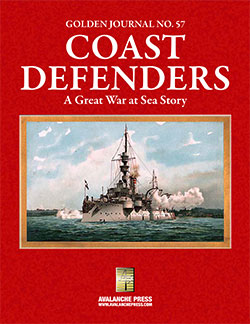 Great War at Sea: Jutland 2e is a brand-new game (as of this writing, it’s actually been out for about six months) using pieces from the old edition of Jutland that we released back in the mid-Zeroes. Since we had plenty of pieces in stock, this seemed a good idea, but over the years since I’ve reconsidered some of the ship ratings. Close study of the actions in the early months of the war brought this home to me: the German High Seas Fleet command made a number of decisions because their ships were simply too crapulent for modern warfare, a situation not fully reflected by the pieces from Jutland. Great War at Sea: Jutland 2e is a brand-new game (as of this writing, it’s actually been out for about six months) using pieces from the old edition of Jutland that we released back in the mid-Zeroes. Since we had plenty of pieces in stock, this seemed a good idea, but over the years since I’ve reconsidered some of the ship ratings. Close study of the actions in the early months of the war brought this home to me: the German High Seas Fleet command made a number of decisions because their ships were simply too crapulent for modern warfare, a situation not fully reflected by the pieces from Jutland.
In terms of game-play, that’s not a serious issue. The ships’ abilities change as the game progresses and they take damage (almost always through combat, but sometimes through other things like running aground). Those changes are noted on the Ship Data Sheets, and those in Jutland 2e show every ship as I think it should be rated, whether or not this agrees with the playing piece.
That still leaves playing pieces showing the old ratings, and while that’s not an issue for playing the game, it is an aesthetic one. And that’s why we have Golden Journal No. 57: Coast Defenders.
Coast Defenders is a special oversized Golden Journal, with 50 “long” ship pieces rather than the usual 20. That’s enough to let us provide nice new pieces for ships I decided to re-value in Jutland 2e, with our fine die-cut and silky-smooth process. That process also demands new artwork, since it shows every flaw that the old methods left invisible. That means that the new ones look really good. Let’s have a look at them.
Coast-Defense Ships

Before Alfred von Tirpitz began his drive for a blue-water navy, the German Reichstag approved a series of small, unoffending coast-defense ships. Armed with three low-powered 240mm (9.4-inch guns) and a ram bow, they were small and slow, but carried a comparatively very large crew of 276 men. They had no business accompanying the fleet into the North Sea to seek battle with the British, yet at Kaiser Wilhelm’s insistence they did so on several 1914 operations (these sorties are addressed in the North Sea 1914 history/analysis book).
Weak as they are in Jutland, they’re still over-rated. Great War at Sea, the game system, classes ships’ guns into three broad categories: primary, secondary, and tertiary. Primary guns are carried by battleships, secondary guns by cruisers, and tertiary guns by destroyers. But not always. There are exceptions, and those are sometimes hard to classify.
The 240mm SK L/35 cannon mounted aboard the German coast-defense ships had been designed in 1888, and even a new 240mm gun doesn’t rate primary status under Great War at Sea’s metrics. So they’re now even weaker in Jutland 2e, which goes a long way toward explaining why High Seas Fleet commander Friedrich von Ingenohl was reluctant to seek battle in August 1914 and doom the 2,200 sailors serving aboard these floating targets.
Early German Dreadnoughts
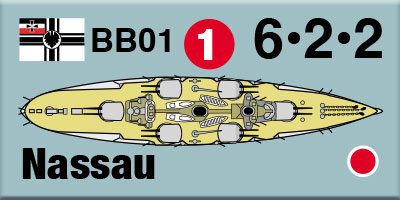
While the Nassau class dreadnoughts of 1907 look like a new development for the High Seas Fleet, a study of the preceding designs for a semi-dreadnought and a smaller, weaker version with only big guns shows quite clearly how the concept evolved from the Deutschland-class pre-dreadnoughts (we did that in Risk Fleet). As such, they carried old-style triple-expansion engines rather than turbines like the British Dreadnought, and were designed for the pre-dreadnoughts’ fleet speed of 19 knots maximum.
That’s well below the Great War at Sea cutoff for a speed of 1; the Nassau class should really be 1-slow, like most older ships in the game. And again, we see that German fleet commanders weren’t nearly as timid as popular histories would have it: in any engagement involving the Nassau class, the High Seas Fleet could not out-run the British Grand Fleet. The British had not only numbers and firepower on their side, they also had a sufficient edge in speed to dictate the terms of engagement (this became evident once the British detached their pre-dreadnoughts from the Grand Fleet, raising the fleet’s maximum speed by three knots). That the German went to sea at all in search of battle was a daring act, even if they sought an uneven battle against just part of the Grand Fleet.
German Pre-Dreadnoughts
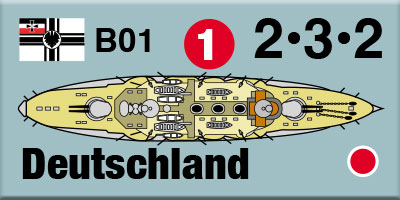

Like the Nassau class, the later German pre-dreadnoughts of the Deutschland and Braunschweig classes are over-rated for speed. They also carried triple-expansion engines, and though their speed was fairly standard for battleships of their day, once turbine-powered dreadnoughts came onto the scene they could not keep up. Like the Nassau class, they participated in most fleet deployments into the North Sea until the Battle of Jutland. At Jutland they even prepared for a suicidal, low-speed torpedo run at the enemy, which thankfully for their crews was called off.
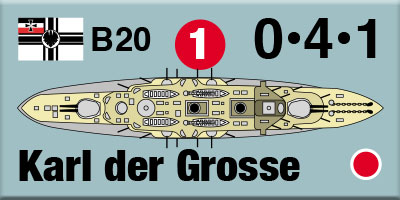
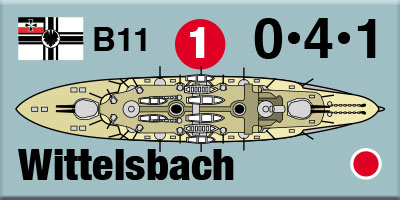
The new pieces give them their proper speed of 1-slow (again, the Jutland 2e ship data already reflects this), and new artwork which shows off their unique appearance. These two classes really did need new art.
British Pre-Dreadnoughts
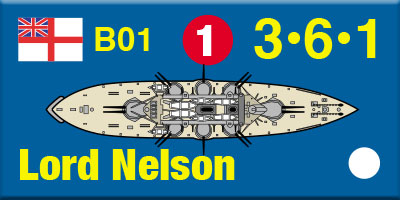
The “Wobbly Eight” battleships of the King Edward VII class were even slower than Nassau and the German pre-dreadnoughts (making just 18.5 knots when new), yet we gave them a speed of 1 because they operated with the Grand Fleet in the first half of World War One (and were available for the Battle of Jutland, appearing in scenarios in Jutland 2e though it’s not likely they’ll reach the battle in time to participate).
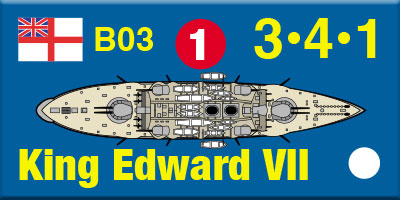
The game already shows the Admiralty’s dissociation from the operational realities of the North Sea battlefield, through its insistence that Sir John Jellicoe take the pre-dreadnoughts along as part of the Grand Fleet. They can’t take nearly as much damage as a dreadnought, and don’t offer much in the way of firepower. Once you give them their proper relative speed, Jellicoe’s position becomes obvious. These ships should not have been exposed to a modern enemy; Winston Churchill believed that he knew better than actual sea officers and only sheer luck avoided an avoidable disaster.
German Armored Cruisers
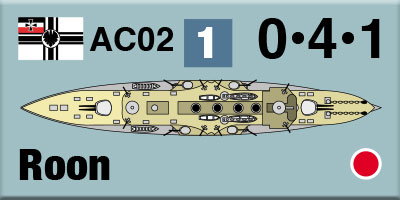
German practice called for each class of battleship to be accompanied by an armored cruiser equivalent. The last of these, Blücher, carried an outstanding weapon (the 210mm, or 8.2-inch, SK L/45, designed in 1905 and used only in Blücher), with range equaling that of the British 12-inch gun that armed early British battle cruisers, and displayed better accuracy.
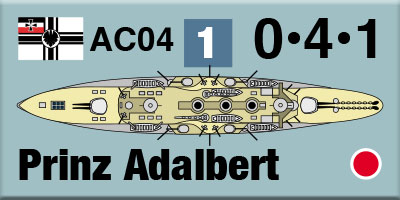
The old Jutland game addressed that by giving Blücher primary gunnery factors, but that’s not a good solution, and in the Second Edition she has a special rule covering her range and only secondary gunnery (which is still sufficient against the tin-clad early British battle cruisers).

Older German armored cruisers had an older-model 210mm gun without those outstanding qualities, and did not deserve a primary gunnery factor at all. A few of these are present in Cruiser Warfare; those that spent the war at home are given new pieces in Coast Defenders.
British Armored Cruisers

The British Mark X 9.2-inch gun was a crapulent weapon, but it armed most of the pre-war armored cruisers and served as secondary armament in the last class of pre-dreadnoughts. The Mark XI that succeeded it (arming the Minotaur-class armored cruisers and Lord Nelson-class semi-dreadnoughts) tried to correct things by extending the barrel and increasing the muzzle velocity; that just made things worse.
Even a good 9.2-inch gun doesn’t really count as a primary gun under Great War at Sea’s rating criteria, and by giving the British armored cruisers a nominal primary factor I also under-valued their secondary prowess, and sort of warped their usage. The armored cruisers are supposed to demolish enemy cruisers, not be demolished by enemy battleships. That was the theory, anyway, rendered obsolete by new turbine-powered battle cruisers that could destroy armored cruisers with ease, and turbine-powered light cruisers that could run away from them with impunity.
Most of the armored cruisers affected by the revised ratings appear in Cruiser Warfare’s second edition; for Coast Defenders, we’ve covered the three ships that remained in the North Sea during those fraught months.
And that’s what we have in Golden Journal No. 57: Coast Defenders. A set of wonderful ship pieces, and the stories of the ships they represent.
The Golden Journal is only available to the Gold Club (that’s why we call it the Golden Journal).
Click here to join the Gold Club.
See your Gold Club Insider newsletter for ordering information.
Sign up for our newsletter right here. Your info will never be sold or transferred; we'll just use it to update you on new games and new offers.
Mike Bennighof is president of Avalanche Press and holds a doctorate in history from Emory University. A Fulbright Scholar and NASA Journalist in Space finalist, he has published a great many books, games and articles on historical subjects; people are saying that some of them are actually good.
He lives in Birmingham, Alabama with his wife, three children, and new puppy. He misses his lizard-hunting Iron Dog, Leopold.
Want to keep Daily Content free of third-party ads? You can send us some love (and cash) through this link right here.
|
